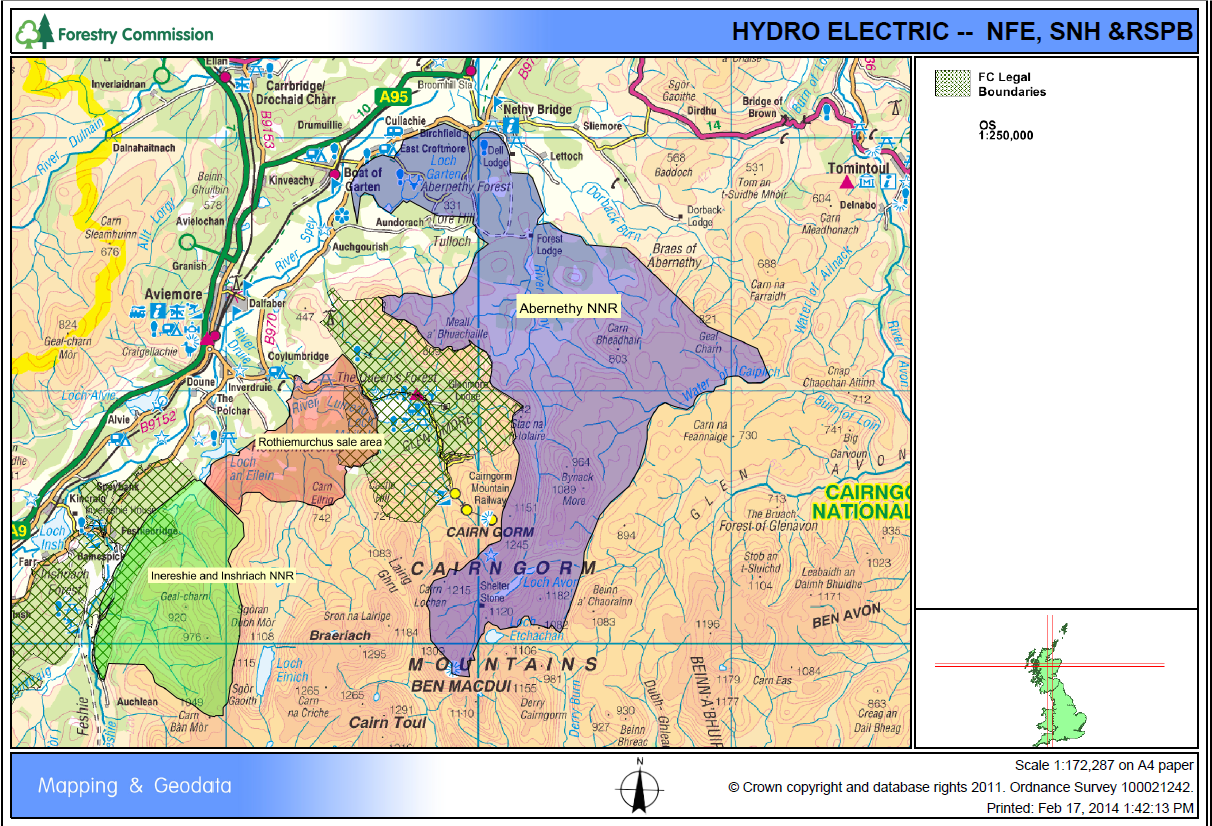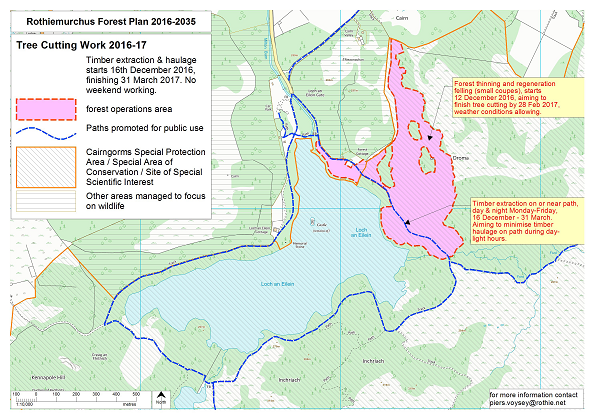
Chris Townsend’s post on Friday on the destruction of trees at Loch an Eilein is well worth a read (see here). Chris highlights the hyprocrisy of some of the people responsible for managing our natural environments, who on the one hand lecture visitors about the damage they do (which is tiny in the scheme of things), but then blithely ignore the extensive damage caused by land owners and managers. The Rothiemurchus estate sign featured in his post is a classic: after the swathe of destruction created by “foresters” chopping down trees, and destroying the ground cove,r the visitor is asked to stay on maintained paths to care for the area (contrary to the Scottish Outdoor Access Code) while the sign also claims, “If this area is not disturbed or trampled, heather and blaeberry will grow back and wildlife will move into this area”. The clear message is visitors are a problem for wildlife but forest operations aren’t.
Rothiemurchus Estate, whose staff tried to stir up hatred against campers because of a fire which burned one granny pine (see here), is now lopping down pine trees that have regenerated naturally. One could also add that its the same Rothiemurchus Estate which is behind the An Camus Mor development (photo above) and is trying to circumvent the planning permission which recently lapsed (post coming soon). The same double-think of course pervades the approach of the Loch Lomond and Trossachs National Park which judges any impact associated with camping as unacceptable (and the reason why it needs to be banned) but ignores the far greater problems that pervade the National Park. The Cairngorms National Park Authority by contrast appears to have had no say in what is happening at Loch an Eilein and indeed the estate refused to participate in the Glenmore Plan, leaving a gaping hole in that strategy.
So, why is the tree felling being allowed to happen at Loch an Eileen?
In April 2014 the Forestry Commission bought a great swathe of the Rothiemurchus Estate from John Grant joining up the publically owned land at Invereshie and Inshriach with the Glenmore Forest Park.

This was done without consultation and cost £7.4m, the largest single investment that Government has ever been made in our National Parks, although the main benefit appears to have been to the private landowner rather than to conservation or public enjoyment of the Park. The shores around Loch an Eileen and where the tree felling has been taking place were however excluded from the sale.
Rothiemurchus receives ongoing public subsidy for managing the Rothiemurchus Estate so, after the sale of upper Rothiemurchus to FCS, a new Forest Plan was required to cover the remaining parts of the estate. It was produced in 2016 (see here) and provides the framework under which woodland is managed on the estate. It is this plan which has been used as the justification for the tree felling around Loch an Eilein


The recreational perspective
Its time that the people responsible for managing “conservation” in our National Parks started to take far more account of the recreational perspective. I believe Chris Townsend’s gut reaction, informed by knowledge of what is natural, was right – the destruction of natural woodland at Loch an Eilein within a protected area should not be allowed. Instead of trying to improve what is there, why not celebrate it as an area where natural processes have predominated for almost a 100 years even if this has resulted in the “wrong-shaped” trees?

What’s happened to the timber ?
It was still lyng around the track in huge piles last time l was there. No doubt the tracks will be even more trashed once the logging lorries have been and collected it.
I am advised to keep my dog on a lead for 6 months the avoid disturbing the wildlife!!!
I really doubt this is being done for commercial reasons, the timber in here is pretty rubbish and there is a lot of but rot in many of the pines here. This area is not particularly important for wildlife as it is to disturbed by visitors as there are numerous paths that intersect the site and from the map published above they are not planning on clearfelling but small scale felling. Distrubance is a natural process and with the majority of the Rothiemurchus forest now under FCS control i don’t see what the issue here is? And i have never seen a forwarder or timber lorry catch a capercallie or deer calf when not under control. Disturbance by forestry machinery looks terrible but the ground will recover naturally and the turning of the soil will improve understorey divesity, trampling of vegetation happens on the same areas day in day out, there is little recovery and it in no way improves biodiversity. This article smacks of prejudice against landowners and jealousy about all the money that has been paid to the estate over the years.
The work in the woodland clearly is an attempt to try and improve biodiversity, what I was questioning is why the Rothiemurchs Forest Plan appears to be trying to improve what has developed naturally (the point being what develops naturally may be less biodiverse than what is managed and maybe there are places where we should accept that?). I believe its possible to be critical without being envious and there are legitimate questions to ask about why the Scottish Government paid so much to buy part of Rothiemurchus while bypassing all the normal consultation procedures, see https://theferret.scot/1m-tax-sweetener-cairngorms-land-deal/
I take your point regarding the Biodiversity angle it is a very difficult balance to make. Some species need large even aged blocks, which often will occur naturally after a fire or other disaster, other species need a mix of open space, young growth and older growth. I think the real problem is the argument over what is “natural” and the isn’t something i think there is an answer to how you manage this, but what is a natural process? Was the fire that cause this block natural? Is the deer control, or not, natural? is the lack of boar, beavers, etc, natural? As we have so little native pine forests it may be the case that these require active management to try to maintain as complete an assemblage of the native species as possible, hence burning, coup felling, fell to waste, using pigs/cattle, etc, to mimic natural processes that can’t/don’t occur regularly enough in the current small fragments of habitat remaining. I would be in favour of more active management, particularly in areas that are currently moorland around the existing native forests to encourage increased semi natural forest cover through planting, and possibly fencing where appropriate as natural regeneration is a very slow and difficult process even where deer numbers are very low. How the government spend their money is up to them and i can’t blame a land owner for accepting it.
I agree, defining what a natural process is, raises various questions and there is no single right answer. My starting point in thinking about this though is what isn’t a natural process? And it seems to me that while people have always formed part of natural ecosytems, that interventions using modern technology (such as the tree cutting equipment etc that has been used at Loch an Eileen) or that aim to achieve something else than a natural functioning ecosystem (muirburn is a good example) should not classed as unnatural. We should therefore not be allowing such interventions to be used in protected areas or places where we want “natural processes” to predominate again. That still leaves questions such as whether we should intervene to reduce deer numbers in the absence of top predators or whether we should re-introduce such species. So, to me the public interest on Rothiemurchus is not to interfere in relately natural areas, like Loch an Eileen, but to stop the muirburn on the upper parts of the estate which stops the forest extending. I don’t think we should be concerned though that this takes time – or even that in places it might not happen – surely that is what putting natural processes first means, its not human who determine the outcomes? I am sceptical about planting schemes, particularly in areas where soils are undisturbed (Cairngorm mountain is different). The wish to speed nature up seems to me to come from the human world of performance indicators – if there are not X number of trees that is a failure – rather than from evidence of how nature works. On the money point, Government money is public money and it seems to me its not just up to the Government to spend. Its worth reading the Rob Edwards piece cited above which shows that the Forestry Commission abandoned all its normal procedures in terms of purchase – and all because the landowner had approached Government asking if they wanted to purchase the land but demanding secrecy. In my view such secret deals are completely wrong.
I don’t know if we really want natural process to predominate in protected areas. We really don’t have enough natural areas large enough anymore for this to be the case. I feel that as we have radically altered both the habitat and species assemblage across virtually the whole of the UK then we are duty bound to maintain what biodiversity we have by maintaining a variety of habitats and also changing, successional habitats, where the removal or coppicing of trees, or the turning of soil, or the cutting of grass or burning of heather is maintained. One example that comes to mind is Flanders moss in Stirlingshire. It is, as far as i am aware, the largest raised bog left in Scotland. If this isn’t managed then due to processes of drainage and peat removal surrounding the site then the bog will dry out and trees will spread in, further drying the site and the unique species that exist there will be lost. I believe in some areas, such as the mountain tops, lakes, most marshes, peat bogs, some islands, then a hands off approach may well be the best option for management. I think where natural process will allow natural regeneration then this is the best policy from an environmental point of view, its just that in most cases natural regeneration is not happening due to either vegetation cover or over grazing, even a low deer density in the wrong place can severely restrict seedlings, if an area is suitable for trees, and would naturally return to forest given time then i think we should give nature a hand, once a forest is there it is much harder to have that land used for something else, such as grazing or grouse. Also out of interest where on Rothiemurchus are they carrying out the muirburn? It’s a while since i have been there but i can’t find anything on google earth from 2016? The only muirburn there I was aware of was that carried out accidently from camp fires and stray cigarettes?
Nicke Kempe, your long very interesting article of 27 March 2017 – please please make your font blacker. Not the pale grey it now is. For older people like me at 83, we need much blacker fonts to be able to read. Just as we need a 150 watt bulb not a 60 watt, to read any book or newspaper.
And now I’m looking at the message ….in pale grey font….that my comment is awaiting moderation……. So it is this website controlling it I assume. So I repeat my request to the website designer please. Black font please, not grey when I struggled to read the article.